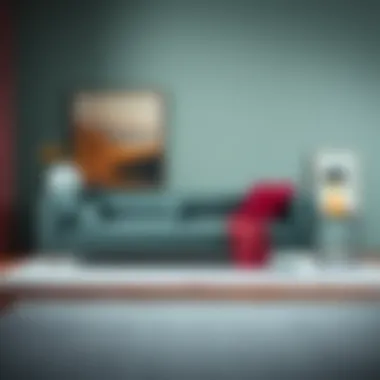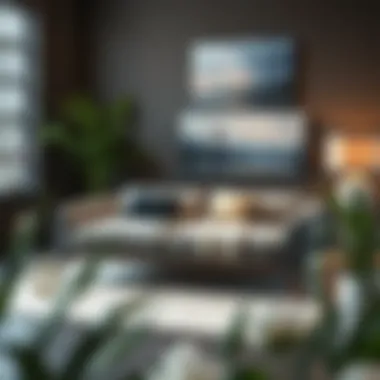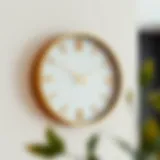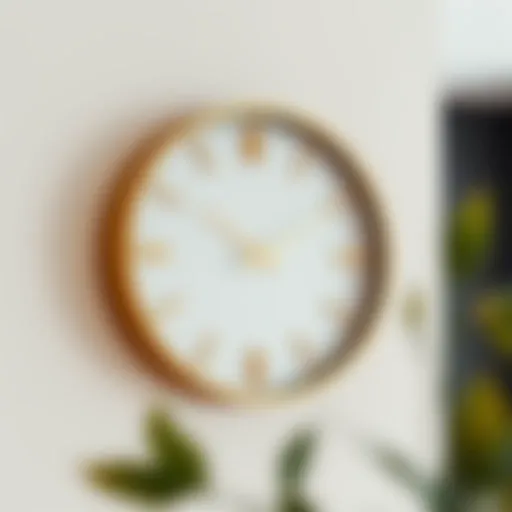Exploring Fabric Day Beds for Modern Interiors


Intro
Fabric day beds have become a focal point in modern interiors, seamlessly marrying style and functionality. These versatile pieces serve multiple purposes—from providing extra seating during gatherings to transforming into a cozy bed for overnight guests. Understanding fabric day beds requires more than just a glance; it encompasses an exploration of design, material, and practicality that appeals to homeowners and decorators alike. This guide will not only delve into the aesthetic qualities of fabric day beds but also discuss their construction, maintenance strategies, and current trends, enriching the reader’s grasp of this essential piece of furniture.
Furniture Design Styles
When it comes to day beds, the design styles are as varied as the colors of a sunset. Let's break down the most popular styles that define the contemporary fabric day bed landscape.
Overview of Popular Styles
- Contemporary: Known for clean lines and minimalist design, contemporary fabric day beds often utilize neutral colors paired with bold accents. They fit perfectly into sleek, modern interiors.
- Bohemian: This style embraces creativity and freedom. Fabric day beds in Bohemian settings feature vibrant patterns, mismatched textiles, and a playful mix of textures.
- Mid-Century Modern: Characterized by simple forms and organic shapes, these day beds often incorporate wooden legs and vintage fabric patterns, adding a nostalgic touch.
- Scandinavian: Emphasizing functionality and simplicity, Scandinavian fabric day beds boast a light color palette and use materials like linen or cotton that evoke an airy feel in the space.
How to Mix and Match Styles
Mixing styles can breathe life into your space, but it requires a deft touch. Here are some tips to harmonize different aesthetics:
- Color Cohesion: Choose a color scheme that ties the various elements together. A common palette can make eclectic styles feel unified.
- Balance Proportions: Pair oversized pieces with slim profiles to maintain a visual balance. For instance, position a luxurious Bohemian day bed beside a sleek contemporary chair.
- Textural Play: Contrast textured fabrics with smooth finishes. A velvet day bed can complement a chunky knit throw and create depth in your design.
Practical Tips for Homeowners
Fabric day beds are a significant investment; hence, selecting and maintaining them requires careful thought. Here are some essential pointers for homeowners.
Essential Buying Tips
- Consider Usage: Assess how often the day bed will be used. For frequent use, opt for durable fabrics and sturdy construction to withstand wear and tear.
- Test Comfort: Don’t shy away from testing a day bed in-store. Sit and lie down to see if it meets your comfort expectations.
- Fabric Choice: Choose fabrics wisely—consider performance fabrics if children or pets are around, as they are designed to resist stains and fading.
Maintenance and Care Guidelines
Keeping your fabric day bed in top shape can prolong its life:
- Regular Cleaning: Vacuum the fabric regularly to remove dust and allergens.
- Stain Treatment: Address spills promptly with a suitable cleaning solution to prevent lasting damage.
- Sun Protection: If placed in direct sunlight, consider window treatments to avoid fading and fabric degradation.
Important: Always check the manufacturer’s care instructions specific to your fabric to ensure long-lasting beauty.
Maintaining a fabric day bed's charm demands dedication, but with the right guidance, it becomes an effortless endeavor. Explore and embrace these various aspects, and you'll surely find the perfect fabric day bed that meets both your aesthetic and functional needs.
Prolusion to Fabric Day Beds
Fabric day beds play a vital role in modern interior design, serving as versatile pieces that blend functionality with aesthetic appeal. As households adapt to smaller living spaces and shifting lifestyles, these furnishings have become increasingly favored for their ability to provide both a seating area and a potential sleeping surface. Understanding the context, dimensions, and decorating potential of fabric day beds can significantly elevate a room's design and utility.
Having a grasp on fabric day beds means knowing not just what they are, but also how they integrate seamlessly into everyday life. This section introduces the foundational elements of these items, highlighting their dual purpose as both a functional bed and a stylish seat. The ability to transform a living room or guest space with the right fabric day bed cannot be overstated, especially in today’s world, where space often comes at a premium.
It’s also essential to consider not only the design but the practical aspects involved when choosing a day bed. Themes such as comfort, fabric type, and overall dimensions play a key part in ensuring the day bed is both visually pleasing and suitable for the user’s needs, creating a well-rounded environment for relaxation or social gatherings.
Definition and Purpose
Fabric day beds are often defined as a hybrid of a bed and a sofa, designed to accommodate a variety of uses in the home. They generally feature a mattress supported by a structure, much like a conventional bed, but are styled in a way that allows them to blend with living spaces.
The primary purpose of these pieces is to offer multifunctional support. In one scenario, they can serve as an attractive seating arrangement during the day, ideal for lounging or as an extra seat when entertaining guests. At night, they can easily convert to a sleeping surface, making them practical for hosting overnight visitors without needing a dedicated guest room. This duality is not only practical but also adds charm and sophistication to any setting.
Benefits of Fabric Day Beds
- Space-saving: Great for smaller apartments or homes where every square foot counts.
- Versatility: Perfect for guest rooms, living rooms, or even home offices, catering to diverse needs.
- Aesthetic appeal: Available in a myriad of designs and fabrics, they can suit various interior styles, from contemporary to traditional.
- Comfort: Curated materials provide support for relaxing activities such as reading or napping, addressing the need for comfort in multiple scenarios.
Historical Context
The concept of day beds isn’t a new one; it dates back centuries. Originally popularized as a form of seating used primarily by the aristocracy during the 19th century, day beds have evolved significantly. While they started as luxurious items often found in palatial homes, their appeal has trickled down to modern-day living.
Throughout the ages, day beds have represented a blend of elegance and practicality. During the Victorian era, they became a staple in parlors, designed for both lounging and socializing. Materials and designs varied vastly, reflecting the style of the time—rich velvets and ornate patterns often dominated the fabric choices.
In contrast, modern interpretations emphasize simplicity and functionality. Designers today draw from historical cues while blending in contemporary materials and styling. Thanks to advances in manufacturing and a focus on comfort, contemporary fabric day beds can be found everywhere from stylish boutiques to popular home furnishing stores. They now cater to a wider demographic, standing as testament to their enduring charm and versatility.
Design Considerations
When choosing a fabric day bed, design considerations are paramount. This encompasses various factors including size, style, and color, all of which contribute significantly to both functionality and aesthetics in a living space. By understanding these elements, one can make informed decisions, ensuring that the day bed not only serves its intended purpose but also enhances the overall decor of the room. The right design can turn a simple piece of furniture into a stunning focal point.
Size and Proportions
The size of a fabric day bed plays a crucial role in how it fits into a space. It's not just about picking something that looks good but ensuring that it complements the surroundings. For instance, in a small apartment, a day bed that is too bulky can overwhelm the area, making it feel cramped. Conversely, a too-small day bed in a vast room may seem insignificant or lost amidst the larger furniture.


Proper proportions can also impact comfort. A bed that is too high or too low may not be ergonomically friendly, affecting how one gets in and out of bed, especially for older adults. This consideration also goes hand-in-hand with the room dimensions. An accurate measurement should be taken to ensure the day bed aligns well without obstructing paths or cluttering spaces.
Style Variations
Contemporary
Contemporary style day beds are characterized by clean lines and a minimalist approach, which makes them a popular choice in many modern homes. With their sleek silhouettes, these beds integrate seamlessly into various design themes, from urban lofts to chic studio apartments. A distinct feature of contemporary day beds is their use of innovative materials and bold colors. This not only adds a splash of personality but also enhances the modern aesthetic. While the benefits include versatility and easy integration into different styles, some may find them less cozy or inviting compared to traditional styles.
Traditional
Traditional fabric day beds showcase classic design elements, often exuding a sense of warmth and nostalgia. They are typically adorned with intricate patterns or rich fabrics like brocade or damask, which lend an air of elegance to any room. The key characteristic of traditional styles is their focus on comfort and ornate details. Such beds can enrich a space with their timeless appeal, making them ideal for vintage environments or for those who appreciate historical decor. However, traditional designs may not fit well into modern or minimalistic spaces, which can limit their appeal in contemporary settings.
Eclectic
Eclectic day beds are all about mixing and matching. This style thrives on combining various design elements, colors, and textures to create a unique look. An eclectic fabric day bed often includes bright, bold patterns or unexpected furniture pieces that showcase individuality and creativity. The hallmark of this style is its ability to tell a story; each piece resonates with personal history or cultural backgrounds.
Choosing an eclectic style allows homeowners to break from the mold of conformity, presenting a refreshing take on interior design. However, the challenge lies in balancing multiple styles cohesively; otherwise, the result might feel chaotic rather than curated.
"A well-designed room is like a great story; it has a beginning, a middle, and an end, leaving a lasting impression."
In summary, understanding the various design considerations when selecting a fabric day bed is essential. Size and proportions ensure it fits well within a space, while style variations cater to differing aesthetics and personal tastes. Thoughtlessness in these areas can lead to a mismatch between the furniture and its environment, detracting from the overall experience of a home.
Material Choices for Upholstery
When diving into the world of fabric day beds, the choice of upholstery material plays a crucial role. It affects not just the look and feel of the bed but also its longevity and functionality. Different materials bring unique characteristics to the table, providing options that cater to various tastes and requirements. By understanding these choices, one can select a day bed that aligns perfectly with both aesthetic desires and practical needs.
Common Fabrics Used
Cotton
Cotton is one of the most popular fabric choices for upholstery. This natural fiber is renowned for its softness and breathability, making it a comfortable option for a day bed where one might relax for extended periods. The key characteristic of cotton is its ability to absorb moisture, which helps regulate temperature. Whether you’re reading on a summer afternoon or entertaining guests, cotton provides comfort. A unique feature is its versatility in design, allowing for a vast array of colors and patterns.
While it has many advantages, such as easy maintenance and durability, cotton can wrinkle and may fade under direct sunlight. However, careful selection and proper care can mitigate these downsides, making cotton a solid choice for fabric day beds.
Linen
Linen stands tall as a timeless classic in upholstery materials. Made from the fibers of the flax plant, linen is celebrated for its unique texture and natural luster. The fabric is breathable and has excellent moisture-wicking properties. This makes it highly suitable for environmental changes, keeping it fresh in hot weather.
The distinguishing feature of linen is its slight sheen, which injects an air of sophistication into any space. Although linen can be prone to wrinkling, this can sometimes add to its charm—imparting an effortless, lived-in quality that many find desirable. Its durability is noteworthy, but it does require some extra care to maintain its elegance over time.
Velvet
Moving into the realm of luxury, velvet is often the fabric of choice for those wanting to make a statement. Its plush and rich texture provides a warm and inviting atmosphere, perfect for spaces requiring coziness. Key characteristics of velvet include its opulence and depth of color, which helps it stand out in a room.
A unique feature here is its ability to reflect light, giving the fabric a dynamic quality that changes as light moves across it. While velvet is undeniably beautiful, this beauty can come with a price—maintenance can be a bit tricky as it tends to attract dust and may require professional cleaning. Nonetheless, when cared for properly, velvet adds unmatched elegance to fabric day beds.
Synthetic Blends
Synthetic blends, often a mix of various fibers, are gaining traction for their practicality. Generally combining polyester with other materials, synthetic blends offer durability and easier maintenance. The key characteristic here is their resistance to stains, fading, and wrinkles, making them an attractive option for busy households.
A unique feature of synthetic blends is their ability to mimic the qualities of more expensive fabrics at a lower price point. While some may argue they lack the authenticity of natural fibers, they make up for it in terms of longevity and ease of care. This means more time enjoying your day bed and less time worrying about upkeep.
Durability and Quality
Durability and quality in fabric day beds are paramount for both aesthetic and functional reasons. Investing in a bed with quality materials ensures that it withstands the test of time, providing comfort and style throughout its lifespan. Choosing high-quality upholstery material means a lower likelihood of wear and tear, and ultimately a more satisfying purchase. In a world where versatility and style are key, a fabric day bed can become an integral piece of furniture that harmonizes with any living space.
"Durability isn't just about how long a product lasts, but how well it serves its purpose throughout its lifetime."
Companies often emphasize the importance of choosing the right material, and rightfully so: a fabric that can stand up to daily use while remaining visually appealing is essential. As such, understanding fabric choices and their roles in the overall quality and durability of a day bed can lead to more informed decisions.
Functional Aspects
Understanding the functional aspects of fabric day beds extends beyond mere aesthetics; it brings into focus the blend of utility and design in modern homes. With more people living in compact spaces, these beds serve as vital assets that cater to a variety of needs. Embracing the multifaceted nature of fabric day beds allows homeowners and designers alike to make informed decisions that facilitate comfort and versatility.
Multi-Use Furniture
One of the most striking benefits of fabric day beds is their ability to function in multiple capacities. Gone are the days when a piece of furniture sat idly, serving single purposes. Nowadays, a fabric day bed can transition from a stylish seating option in a living room to a cozy bed for overnight guests, truly embodying the spirit of multi-use furniture.
When evaluating a fabric day bed, it's crucial to consider the layout of the space. Here’s why:


- Space Efficiency: In smaller homes or apartments, every square foot counts. A day bed that can serve as both seating and sleeping arrangements maximizes utility.
- Flexible Design: They come in various styles, fitting seamlessly into areas such as the living room, den, or guest space without overwhelming the decor.
- Ease of Transition: Most fabric day beds can be quickly transformed from a sofa to a bed, making them highly practical for unexpected visitors.
Incorporating one not only enhances functionality but also elevates the overall look of your interior, marking it as both chic and sensible.
Comfort and Ergonomics
Comfort and ergonomics are paramount in choosing any piece of furniture. A fabric day bed should not only look appealing but also provide a restful experience. When contemplating comfort, we must consider the following aspects:
- Quality of Mattress: An essential part of a fabric day bed's comfort is the mattress quality. It can greatly affect sleep quality and overall satisfaction. Opt for options with memory foam or pocket springs for optimal support.
- Back Support: The backrest of a day bed should encourage good posture whether it’s in use as a sofa or a bed. Select designs that offer ample lumbar support without sacrificing aesthetics.
- Textile Choices: The fabric chosen impacts both comfort and usability. Softer, breathable materials such as cotton or linen are preferable for extended sitting or lying down.
"The key to a great fabric day bed is striking the fine balance between comfort, flexibility, and design."
Homeowners can also enhance the comfort level through cushions, throws, or bed linens that suit their personal style and elevate functionality. This dual focus on ergonomic design alongside adaptive uses provides a superior experience, making these beds a worthy investment in any home.
For additional reading on space saving furniture ideas, check out Wikipedia and explore forums on Reddit for inspiration.
Selecting the Right Fabric Day Bed
Choosing the right fabric day bed can feel like hunting for a needle in a haystack, especially in an age where aesthetics and functionality collide. A fabric day bed isn’t just a piece of furniture; it can transform a room, providing comfort and versatility while echoing a homeowner’s style. With so many considerations at play, it's crucial to approach the selection process with a clear understanding of space needs and personal preferences.
Assessing Room Dimensions
Before you fall head over heels for the latest trending fabric day bed, it’s vital to size up your space. An ill-fitted day bed can turn a cozy nook into a cramped corner, where neither beauty nor practicality flourishes. Measuring your room’s dimensions helps prevent any clashes between your selected piece and the overall layout of your home.
When evaluating room dimensions, consider following these steps:
- Measure Height, Width, and Depth: Not just the floor space; also think about ceiling height. A tall day bed might create a feeling of being boxed in.
- Consider Entryways: Doors and windows can affect how the day bed fits—its height should not obstruct natural light or pathways.
- Account for Movement: Leave room for passage. You don’t want to play a game of furniture Tetris every time you want to rearrange.
Ultimately, ensuring your fabric day bed fits the physical structure of your space can aid in maintaining a defined aesthetic while also supporting the day-to-day usability.
Matching Aesthetics with Functionality
Next comes the delightful yet daunting task of pairing what you want to see with what you need to do. Fabric day beds offer an array of styles that can complement various interior themes—from minimalist to bohemian. However, the secret sauce lies between harmonizing this aesthetic appeal with functional needs.
To achieve a perfect balance:
- Identify Usage: Determine how you plan to use the day bed. Will it be a reading nook, a guest bed, or a daily lounging spot? Each use case might steer you towards different styles or features.
- Color and Texture Considerations: A striking pattern might steal the spotlight, but consider its compatibility with existing decor. A striped day bed can clash with floral wallpaper. On the flip side, solid colors can provide a neutral stage for colorful accessories.
- Functional Add-Ons: Look for features that enhance usability—think storage drawers underneath for blankets and pillows, or bolsters that double as decorative cushions.
Matching aesthetics with functionality should never be an afterthought; rather, it’s about wheeling and dealing to find a middle ground that sings harmony throughout your space.
"Considering both style and practicality can elevate the function of a day bed from just an extra seat to a multifunctional staple."
Maintenance and Care
Caring for fabric day beds goes beyond just their initial purchase; it’s vital to ensure their longevity and pristine appearance. Proper maintenance can greatly enhance both the lifespan of the materials and the aesthetic appeal of these versatile pieces. When selecting a fabric day bed, it’s easy to get caught up in its visual beauty and functionality, but neglecting the upkeep can lead to premature wear-and-tear. Thus, understanding the best practices for maintenance not only safeguards your investment but can also enhance the comfort and enjoyment you derive from these furnishings.
Cleaning Guidelines
Spot Cleaning
Spot cleaning is an essential skill for keeping fabric day beds looking their best. It’s the immediate reaction to spills, stains, or any unexpected mishaps that occur. This technique focuses on addressing blemishes before they set in, making it a quick intervention that can save a lot of headaches later on.
The key characteristic of spot cleaning is its ability to deal with localized messes effectively. By using mild detergents or upholstery cleaners, one can often lift stains without the risk of damaging the fabric or altering its color. It’s often considered a practical choice due to its beneficial nature; after all, who wants to grapple with a big stain when a little diligence could have avoided it?
Unique to spot cleaning is its flexibility. It allows homeowners or designers to handle issues as they arise. However, neglecting to apply the proper technique can sometimes lead to unsatisfactory results—like spreading the stain instead of lifting it. Thus, having handy tips and tricks for spot cleaning becomes crucial in maintaining the fabric's vibrant look.
Deep Cleaning Techniques
While spot cleaning tackles immediate issues, deep cleaning techniques are equally important for comprehensive maintenance. It involves more thorough cleaning regimens that dive deeper into the fabric fibers and underlying materials. This method eradicates dust, allergens, and debris that could otherwise accumulate over time.
The key characteristic of deep cleaning is its comprehensive nature, which often employs steam cleaning or specialized upholstery cleaners to rejuvenate the fabric. It's beneficial, particularly for those with allergies or households with pets. However, it requires a bit more effort and planning—unlike spot cleaning that offers immediate results.
What’s unique about deep cleaning is its ability to refresh the day bed’s appearance while potentially extending the fabric's life span, removing deep-seated dirt that could lead to gradual deterioration. On the downside, this process usually necessitates more time, equipment, and in some cases, professional assistance.
Protective Measures
Implementing protective measures is vital to ensure the longevity of fabric day beds. Protective sprays, like those that repel stains or moisture, can shield the fabric and minimize the risk of damage. These treatments can add a layer of defense against spills and pet interactions, making day-to-day life easier.
Regular maintenance routines, combined with proactive measures, create a dynamic defense system against everyday wear. Investing time in both cleaning and protective upkeeping will certainly lead you to reap benefits in the long run. If a little care goes a long way, then an ounce of prevention is worth a pound of cure.


Current Trends in Fabric Day Beds
The world of fabric day beds is ever-evolving, and staying abreast of current trends can significantly enhance their functionality and aesthetic appeal. For designers, retailers, homeowners, and decorators, understanding these trends is crucial for making informed decisions.
As more people seek versatility in their interiors, fabric day beds have risen to prominence, serving multiple purposes. They not only provide sleeping space but also fit seamlessly with various design styles and environments. The current trends focus on sustainability, innovation, and adaptability, reflecting a deeper societal shift towards mindful living and aesthetic integration in home furnishings.
Sustainable Fabrics
The emphasis on sustainability is reshaping the choices consumers make in furniture and upholstery. Fabrics such as organic cotton, hemp, and recycled polyester are gaining traction. This shift is not simply a trend but a necessity as individuals become increasingly aware of the ecological impacts of their purchases.
Choosing sustainable fabrics may seem daunting at first, but it offers several advantages:
- Environmental Impact: Using materials that are eco-friendly reduces waste and consumption of non-renewable resources.
- Health Considerations: Many sustainable fabrics are free from harmful chemicals, contributing to a healthier living environment.
- Durability: Often, these materials are designed to be more resilient, standing up to wear and tear better than traditional fabrics.
Modern consumers are looking not just for aesthetic value but also for peace of mind in knowing that their furniture choices reflect their values. In essence, the adoption of sustainable fabrics contributes to a larger narrative of responsible living.
Innovative Designs and Features
Alongside fabric choices, innovations in design and functionality are also shaping the current landscape of day beds. From modular configurations to convertible designs, the options are expanding remarkably.
Some noteworthy aspects include:
- Multi-functional Features: Day beds today can often be converted into sofas, with built-in storage options, or can even transform into full-size beds.
- Customization Options: Consumers can choose from a range of colors, patterns, and finishes, allowing personal expression in their homes.
- Adaptable Materials: New technology has led to fabric finishes that enhance longevity and ease of cleaning, ensuring that the day bed remains a practical choice as lifestyles evolve.
As day beds become focal points in living spaces, the integration of innovative features helps meet diverse lifestyle needs, especially in urban settings where space is at a premium.
Taken together, sustainable fabrics and innovative designs pave the way for a fresh perspective on fabric day beds that resonate with contemporary values.
Versatility in Different Spaces
Fabric day beds are more than just a place to catch a quick nap; they adapt seamlessly to different environments, transforming spaces according to need and style. Their versatility is a major selling point for homeowners and decorators alike, as they serve various functions while also adding visual interest to the room. To get a real understanding, let's break this down into distinct areas where fabric day beds shine.
Living Rooms
In the living room, a fabric day bed can take center stage, serving a dual purpose as a cozy seating area and an occasional sleep space. With an array of designs available, from sleek contemporary to traditional patterns, these pieces can tie a room together, enhancing the overall decor.
- Style Versatility: A day bed can be dressed up with throw pillows and a stylish blanket for daily use while easily converting into a guest bed at night.
- Space Optimization: Perfect for apartments with limited space, they can be placed against a wall or positioned to define a smaller area within a large room. Furthermore, many designs incorporate storage underneath, allowing for easy stashing of linens or small items.
"A well-placed fabric day bed not only maximizes utility but also elevates the aesthetic appeal of the living space."
Guest Rooms
Guest rooms can be a bit tricky to design; they need to be inviting yet functional. Fabric day beds excel here, balancing comfort and design with practicality:
- Comfort for Guests: When outfitted with a plush mattress, a fabric day bed offers a comfortable sleeping surface that rivals traditional beds. Plus, you can adapt the bedding style to match the overall theme of the room.
- Flexible Arrangement: They provide versatility in arrangements. Depending on the space, the day bed can be the focal point or complement other furniture. It also saves on needing an extra bed, making them ideal for smaller guest rooms.
Home Offices
As remote work becomes increasingly popular, home offices need to be both functional and comfortable. A fabric day bed can play a significant role here:
- Recreational Area: During breaks, having a day bed nearby allows for quick rest or relaxation without needing to venture far from work. It can act as a mini retreat within your workspace.
- Design Cohesion: With a multitude of fabric options, day beds can be integrated into any office aesthetic, whether it's boho chic or modern minimalism. This means you don't have to sacrifice style for functionality; instead, they offer a cohesive flow to the room.
In summary, the adaptability of fabric day beds makes them indispensable in various spaces, whether they serve as a centerpiece in the living room, a cozy guest bed, or a restful nook in a home office. This unique versatility caters not only to practical needs but also enhances the beauty of the interiors they occupy.
End and Future Outlook
As we draw the curtain on our exploration of fabric day beds, it's essential to consider not just what we've learned, but also the direction in which this furniture trend is heading. Fabric day beds embody a unique blend of style and practicality, making them pivotal in contemporary home design. While they were once merely a practical solution for accommodating guests or maximizing space, today’s fabric day beds are increasingly viewed as the focal points of a room, harmonizing aesthetics with comfort and functionality.
Summarizing Key Insights
Throughout this comprehensive examination, several key insights about fabric day beds surface:
- Versatile Design: These pieces can transition effortlessly between different uses—from a cozy reading nook to a chic sleeping space.
- Material Diversity: Choosing the right upholstery fabric is paramount—not simply for comfort but also for style longevity. Cotton, linen, velvet, and durable synthetic blends each offer distinct benefits, aligning with varied interior designs and personal preferences.
- Maintenance Matters: Regular upkeep is crucial, with specific cleaning techniques ensuring that the day bed not only looks good but also withstands daily wear and tear.
- Trends on the Rise: Sustainability is becoming a centerpiece in fabric choices, with organic and recycled materials gaining popularity, proving that conscious choices can align with style.
"The best day beds are those that reflect the owner's personality while catering to their space needs."
The intersection of these insights marks a shift in how we approach furniture selection, encouraging us to think beyond mere functionality.
The Evolving Role of Fabric Day Beds in Home Design
Fabric day beds are increasingly being recognized as more than just additional sleeping surfaces; they are integral elements of design. Traditionally, day beds might have been relegated to guest rooms or less prominent spaces, but now, they find themselves showcased prominently in living rooms, dens, and even outdoor areas. This evolution is largely driven by:
- Hybrid Living Spaces: With more people embracing open-concept living, the need for multifunctional furniture has surged. Fabric day beds fit this bill, providing lounging and sleeping options without taking up excessive space.
- Customized Aesthetic Appeal: Homeowners are gravitating towards personalized decor, encouraging designers and retailers to offer bespoke options. From fabrics to frame styles, the array of personalization available today invites creative expression in home design.
- Shift Towards Comfort: The modern consumer prioritizes comfort in design. Fabric day beds, with their soft upholstery and layered textures, align beautifully with current trends favoring relaxed, inviting environments.
As we look ahead, we can anticipate fabric day beds evolving further, keeping pace with changing lifestyles and preferences. The fusion of sustainability, functionality, and artistic expression suggests a bright future for these versatile pieces in interior design.















